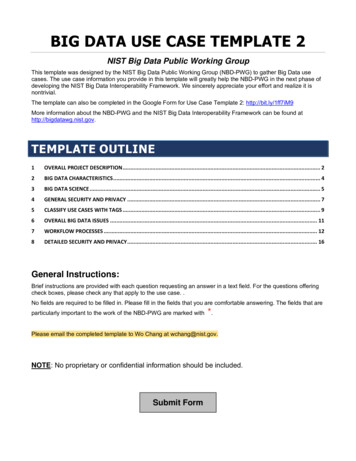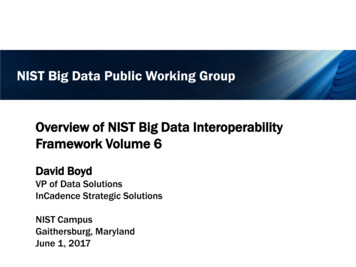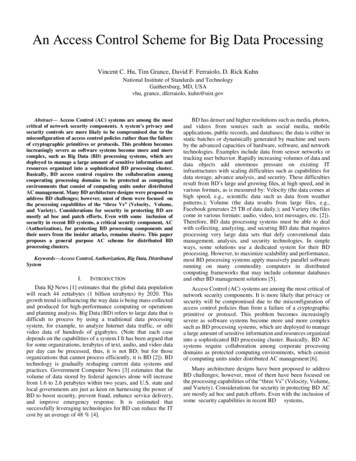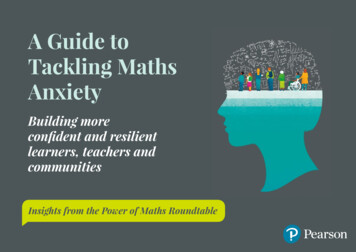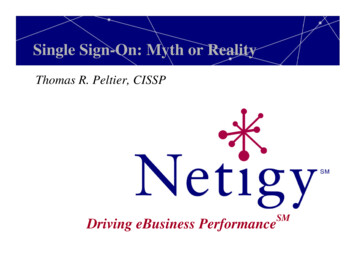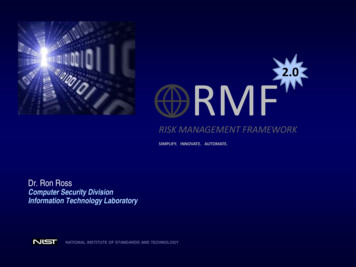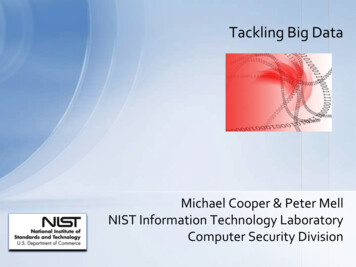
Transcription
Tackling Big DataMichael Cooper & Peter MellNIST Information Technology LaboratoryComputer Security Division
IT Laboratory Big Data Working Group What exactly is Big Data? What are the issues associated with it? What role should NIST play with regard to Big Data? What is the relationship between Big Data and ITSecurity?
What is Big Data? You know it when you see it . NIST– Astronomical Image data from ALMA 1Tb / day– Border Gateway Protocol (BGP) Data 10 Tb Government– Census– NIH/ NCI Industry– Amazon– Google
What are the issues associated with Big Data? Taxonomies, ontologies, schemas, workflowPerspectives – backgrounds, use cases Bits – raw data formats and storage methodsCycles – algorithms and analysisScrews – infrastructure to support Big Data
IT Security and Big Data Big data sources become rich targets Composition of data in one large source as well asacross sources Security data becoming the source for big datarepositories– Log/event aggregation and correlation– IDS/IPS databases
NIST ITL Big Data Planned Activities ITL/SSD Big Data Workshop – 13 – 14 June NIST Internal workshop this summer Government/ industry / academia conference thisfall
An Overview of Big DataTechnology and SecurityImplicationsPeter MellSenior Computer ScientistNIST Information Technology Laboratoryhttp://twitter.com/petermmell
DisclaimerThe ideas herein represent the author’s notional views onbig data technology and do not necessarily represent theofficial opinion of NIST.Any mention of commercial and not-for-profit entities,products, and technology is for informational purposesonly; it does not imply recommendation or endorsementby NIST or usability for any specific purpose.NIST Information Technology Laboratory
Presentation Outline Section 1: Introduction and DefinitionsSection 2: Big Data TaxonomiesSection 3: Security Implications and Areas of ResearchSection 4: MapReduce and HadoopSection 5: Notable ImplementationsAppendix A: Seminal Research ResultsAppendix B: Overview of Big Data Framework TypesNIST Information Technology Laboratory
Section 1: Introduction and DefinitionsNIST Information Technology Laboratory
Big Data – the Data Deluge The world is creating ever more data– (and it’s a mainstream problem) Mankind created data– 150 exabytes in 2005 (exabyte is a billion gigabytes)– 1200 exabytes in 2010– 35000 exabytes in 2020 (expected by IBM) Examples:––––––U.S. drone aircraft sent back 24 years worth of video footage in 2009Large Hadron Collider generates 40 terabytes/secondBin Laden’s death: 5106 tweets/secondAround 30 billion RFID tags produced/yearOil drilling platforms have 20k to 40k sensorsOur world has 1 billion transistors/humanCredit: The data deluge, Economist; Understanding Big Data, Eaton et al.11
A Quick Primer on Data Sizes12
Predictions of the “Industrial Revolutionof Data” – Tim O’Reilly Data is the new “raw material ofbusiness” – Economist Challenges to achieving therevolution– It is not possible to store all thedata we produce– 95% of created information wasunstructured in 2010 Key observation– Relational database managementsystems (RDBMS) will bechallenged to scale up or out tomeet the demandCredit: Data data everywhere, Economist; Extracting Value from Chaos, Gantz et al.13
Industry Views on Big Data O’Reilly Radar definition:– Big data is when the size of the data itself becomes part ofthe problem EMC/IDC definition of big data:– Big data technologies describe a new generation of technologiesand architectures, designed to economically extract value fromvery large volumes of a wide variety of data, by enabling highvelocity capture, discovery, and/or analysis. IBM says that ”three characteristics define big data:”– Volume (Terabytes - Zettabytes)– Variety (Structured - Semi-structured - Unstructured)– Velocity (Batch - Streaming Data) Microsoft researchers use the same tupleCredit: Big Data Now, Current Perspectives from O’Reilly Radar (O’Reilly definition); Extracting Value from Chaos, Gantz et al. (IDC definition);Understanding Big Data, Eaton et al. (IBM definition) ; The World According to LINQ, Meijer (Microsoft research)14
Notional Definition for Big Data Big Data– Big data is where the data volume, acquisition velocity, ordata representation limits the ability to perform effectiveanalysis using traditional relational approaches or requiresthe use of significant horizontal scaling for efficientprocessing.Big DataBig DataScienceBig DataFrameworkBig DataInfrastructure15
More Notional Definitions Big Data Science– Big data science is the study of techniques covering the acquisition,conditioning, and evaluation of big data. These techniques are asynthesis of both information technology and mathematicalapproaches. Big Data Frameworks– Big data frameworks are software libraries along with theirassociated algorithms that enable distributed processing andanalysis of big data problems across clusters of compute units (e.g.,servers, CPUs, or GPUs). Big Data Infrastructure– Big data infrastructure is an instantiation of one or more big dataframeworks that includes management interfaces, actual servers(physical or virtual), storage facilities, networking, and possiblyback-up systems. Big data infrastructure can be instantiated tosolve specific big data problems or to serve as a general purposeanalysis and processing engine.16
Big Data Frameworks are oftenassociated with the term NoSQL NoSQL OriginsStructuredStorageRDBMSNoSQL– First used in 1998 to mean “No to SQL”– Reused in 2009 when it came to mean “Not Only SQL”– Groups non-relational approaches under a single term The power of SQL is not needed in all problems– Specialized solutions may be faster or more scalable– NoSQL generally has less querying power than SQL Common reasons to use NoSQL– Ability to handle semi-structured and unstructured data– Horizontal scalability NoSQL may complement RDBMS (but sometimesreplaces)– RDBMS may hold smaller amounts of high-value structured data– NoSQL may hold vast amounts of less valued and less structureddataCredit: NoSQL Databases, Strauch; Understanding Big Data, Eaton et al.17
Common Tradeoffs Between Relational and NoSQLApproaches Relational implementations provide ACID guarantees––––Atomicity: transaction treated an all or nothing operationConsistency: database values correct before and afterIsolation: events within transaction hidden from othersDurability: results will survive subsequent malfunction NoSQL often provides BASE– Basically available: Allowance for parts of a system to fail– Soft state: An object may have multiple simultaneous values– Eventually consistent: Consistency achieved over time CAP Theorem– It is impossible to have consistency, availability, andpartition tolerance in a distributed system– the actual theorem is more complicated (see CAP slide inappendix A)Credit: Principles of Transaction-Oriented Database Recovery, Haerder and Reuter, 1983; Base: An ACID Alternative, Pritchett, 2008;Brewer’s Conjecture and the Feasibility of Consistent, Available, Partition-Tolerant Web Services, Gilbert and Lynch18
CAP Theorem with ACID and BASE VisualizedACID witheventual availabilityPartitionToleranceConsistencyBASE witheventual consistencyAvailabilitySmall data sets can be bothconsistent and available19
Section 2: Big Data TaxonomiesNIST Information Technology Laboratory
Big Data Characteristics andDerivation of a Notional TaxonomyVolumeVelocityVariety(semi-structuredor alLimitationBig aybeYesMaybeYesNoYes, Type 1Yes, Type 2Yes, Type 3Yes, Type 2Yes, Type3Yes, Type 2Yes, Type 3Types of Big Data:Type 1: This is where a non-relational data representation required for effective analysis.Type 2: This is where horizontal scalability is required for efficient processing.Type 3: This is where a non-relational data representation processed with a horizontallyscalable solution is required for both effective analysis and efficient processing.In other words, the data representation is not conducive to a relational algebraic analysis.21
NoSQL Taxonomies Remember that big data frameworks and NoSQL arerelated but not necessarily the same– some big data problems may be solved relationally Scofield: Key/value, column, document, graphCattel: Key/value, extensible record (e.g., column), documentStrauch: Key/value, column, document (mentions graph separately)Others exist with very different categories Consensus taxonomy for NoSQL:– Key/value, column, document, graph Notional big data framework taxonomy:– Key/value, column, document, graph, sharded RDBMSsCredit: NoSQL Databases, Strauch; NoSQL Death to Relational Databases(?), Scofield; Scalable SQL and NoSQL Data Stores, Cattel22
Notional Big DataFramework TaxonomyConceptual Structures:Key Value StoresSchema-less systemColumn-oriented databasesStorage by column, not rowValueKeyNameHeightEye psGraph DatabasesUses nodes and edges to represent dataOften used for Semantic WebDocument Oriented DatabaseStores documents that are semi-structuredIncludes XML databasesSharded edDocumentRDBMSRDBMS23
Comparison of NoSQL and Relational ity in ComplexityFunctionalityData Variety of storeshighvariable (high)highlowvariable (low)Graphdatabasesvariablevariablehighhighgraph terelationalalgebraMatches columns on the big data taxonomyCredit: NoSQL Death to Relational Databases(?), Scofield (column headings modified from original data for clarity)24
Notional Suitability of Big Data Frameworksfor types of Big Data ProblemsHorizontalScalabilityFlexibility inData VarietyAppropriateBig Data TypesKey-Valuestoreshighhigh1, 2, 3Column storeshighmoderate1 (partially), 2,3 (partially)Documentstoresvariable (high)high1, 2 (likely),3 (likely)Graphdatabasesvariablehigh1, 2 (maybe),3 (maybe)ShardedDatabasevariable (high)low2 (likely)25
Section 3: Security Implications and Areas ofResearchNIST Information Technology Laboratory
Hypothesis: Big Data approaches will open up newavenues of IT security metrology “Revolutions in science have often beenpreceded by revolutions in measurement,” Sinan Aral, New York University Arthur Coviello, Chairman RSA– “Security must adopt a big data view The age ofbig data has arrived in security management.”– We must collect data throughout the enterprise,not just logs– We must provide context and perform real timeanalysis There is precious little information on how todo thisCredit: Data, data everywhere, Economist; oud-resilient-security27
Big Data is Moving into IT Security Products Several years ago, some security companies had anepiphany:– Traditional relational implementations were not alwayskeeping up with data demands A changed industry:––––Some were able to stick with traditional relational approachesSome partitioned their data and used multiple relational silosSome quietly switched over to NoSQL approachesSome adopted a hybrid approach, putting high value data in arelational store and lower value data in NoSQL storesCredit: This is based on my discussions with IT security companies in 12/2011 at the Government Technology Research Alliance Security Council 2011
Security Features are Slowly Moving intoBig Data Implementations Many big data systems were not designed with securityin mind – Tim Mather, KPMG There are far more security controls for relationalsystems than for NoSQL systems– SQL security: secure configuration management, multifactorauthentication, data classification, data encryption,consolidated auditing/reporting, database firewalls,vulnerability assessment scanners– NoSQL security: cell-level access labels, kerberos-basedauthentication, access control lists for tables/column familiesCredit: Securing Big Data, Cloud Security Alliance Congress 2011, Tim Mather KPMG29
Public Government Big DataSecurity Research Exists Accumulo– Accumulo is a distributed key/value store that providesexpressive, cell-level access labels.– Allows fine grained access control in a NoSQLimplementation– Based on Google BigTable– 200,000 lines of Java code– Submitted by the NSA to the Apache FoundationCredit: http://wiki.apache.org/incubator/AccumuloProposal, erprise-apps/23160083530
What further research needs to be conducted on bigdata security and privacy? Enhancing IT security metrology Enabling secure implementations Privacy concerns on use of bigdata technology31
Research Area 1: The ComputerScience of Big Data1. What is a definition of big data?– What computer science properties are we trying to instantiate?2. What types of big data frameworks exist?– Can we identify a taxonomy that relates them hierarchically?3. What are the strengths, weaknesses, and appropriateness ofbig data frameworks for specific classes of problems?– What are the mathematical foundations for big data frameworks?4. How can we measure the consistency provided by a big datasolution?5. Can we define standard for querying big data solutions?With an understanding of the capabilities available and theirsuitability for types of problems, we can then apply thisknowledge to computer security.32
Research Area 2: Furthering IT SecurityMetrology through Big Data Technology1. Determine how IT security metrology is limited by traditionaldata representations (i.e., highly structured relationalstorage)2. Investigate how big data frameworks can benefit IT securitymeasurement What new metrics could be available?3. Identify specific security problems that can benefit from bigdata approaches Conduct experiments to test solving identified problems4. Explore the use of big data frameworks within existingsecurity products What new capabilities are available? How has this changed processing capacity?33
Research Area 3: The Security ofBig Data Infrastructure1. Evaluate the security capabilities of big datainfrastructure– Do the available tools provide needed security features?– What security models can be used when implementing bigdata infrastructure?2. Identify techniques to enhance security in big dataframeworks (e.g., data tagging approaches, sHadoop)– Conduct experiments on enhanced security frameworkimplementations34
Research Area 4: The Privacy of Big DataImplementations Big data technology enables massive data aggregationbeyond what has been previously possible Inferencing concerns with non-sensitive data Legal foundations for privacy in data aggregation Application of NIST Special Publication 800-53 privacycontrols35
Needed Research Deliverables Area 1 (not security specific)– Publication on harnessing big data technology Definitions, taxonomies, and appropriateness for classesof problems Area 2 (security specific)– Publication on furthering IT security metrology through bigdata technology– Research papers on solving specific security problems usingbig data approaches Area 3 (security specific)– Publication on approaches for the secure use of big dataplatforms Area 4 (privacy specific)– Not yet identified36
Section 4: MapReduce and HadoopNIST Information Technology Laboratory
MapReduce –Dean, et al. Seminal paper published by Google in 2004– Simple concurrent programming model and associated implementation Model handles the parallel processing and message passingdetails– Simplified coding model compared to general purpose parallel languages(e.g., MPI) Three functions: Map - Parallel sort - Reduce– Map: Processes a set of key/value pairs to produce an intermediate set ofkey/value pairs– Parallel sort: a distributed sort on intermediate results feeds the reducenodes– Reduce: for each resultant key, it processes each key/value pair andproduces the result set of values for each key Approachable programming model– Handles concurrency complexities for the user– Limited functionality– Appears to provide a sweet spot for solving a vast number of importantproblems with an easy to use programming modelCredit: MapReduce: Simplified Data Processing on Large Clusters, Dean et al.38
MapReduce Diagram from Google’s2004 Seminal Papere39
Storage, MapReduce, and Query(SMAQ) StacksQuery Efficient way of defining computation Platform for user friendly analyticalsystemsMapReduce Distributes computation over manyservers Batch processing modelStorage Distributed and non-relationalCredit: 2011 O’Reilly Radar, Edd Dumbill40
Hadoop Widely used MapReduce framework “The Apache Hadoop software library is a frameworkthat allows for the distributed processing of large datasets across clusters of computers using a simpleprogramming model” – hadoop.apache.org Open source project with an ecosystem of products Core Hadoop:– Hadoop MapReduce implementation– Hadoop Distributed File System (HDFS) Non-core: Many related projectsCredit: http://hadoop.apache.org41
Hadoop SMAQ Stack (select components)QueryMap ReduceStorage Pig (simply query language)Hive (SQL like queries)Cascading (workflows)Mahout (machine learning)Zookeeper (coordination service)Hama (scientific computation) Hadoop Map Reduce implementation HBase (column oriented database) Hadoop Distributed File System(HDFS, core Hadoop file system)42
Alternate MapReduce Frameworks BashReduceDisco ProjectSparkGraphLab Carnegie-MellonStormHPCC (LexisNexis)43
Section 5: Notable Implementations(both frameworks and infrastructure)NIST Information Technology Laboratory
Google File System –Ghemawat, et al. Design requirements: “performance, scalability,reliability, and availability” Design assumptions:––––Huge filesExpected component failuresFile mutation is primarily by appendingRelaxed consistency - think of the CAP theorem here Master has all its data in memory (consistent andavailable!!) All reads and writes occur directly between client andchunkservers For writes, control flow is decoupled from pipelineddata flowCredit: The Google File System, Ghemawat et al.45
Google File System Architecture46
Google File System Write Control and Data Flow Master assigned aprimary replica Client pipelines datathrough replicas Client contactsprimary to instantiatethe write47
Big Table –Chang, Dean, Ghemawat, et al. “Big table is a sparse, distributed, persistent multidimensional sorted map”– It is a non-relational key-value store / column-oriented database Row keys- table data is stored in row order– Model supports atomic row manipulation Tablets- subsets of tables (a range of the rows)– Unit of distribution/load balancing Column families group column keys– Access control done on column families Each cell can contain multiple time stamped versionsUses Google File System (GFS) for file storageDistributed lock service- ChubbyImplementation- Lightly loaded master plus tablet serversInternal Google toolCredit: Bigtable: A Distributed Storage System for Structured Data, Chang et. al.48
Big Table Storage ParadigmColumn familyColumn keyColumn familyRow keyTimestamp49
Hbase Open source Apache project– Modeled after the Big Table research paper– Implemented on top of the Hadoop Distributed File System “Use HBase when you need random, realtimeread/write access to your Big Data hosting of verylarge tables -- billions of rows X millions of columns -atop clusters of commodity hardware. HBase is anopen-source, distributed, versioned, column-orientedstore modeled after Google's Bigtable”Cre
–Big data infrastructure is an instantiation of one or more big data frameworks that includes management interfaces, actual servers (physical or virtual), storage facilities, networking, and possibly back-up systems. Big data infrastructure can be instantiated to solve specific big data problems or to serve as a general purpose

